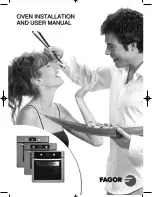
5
microwave use.
Styrofoam plates and cups
— These can
melt and leave an unhealthy residue on food.
Plastic storage and food containers
—
Containers such as margarine tubs can melt in
the microwave.
Metal utensils — These can damage your oven.
Remove all metal before cooking.
Note:
TO TEST A CONTAINER FOR SAFE
MICROWAVE OVEN USE: Fill a 8 oz (250ml)
glass measure with water and place it in the
microwave oven along with the container to be
tested; heat one minute at HIGH. If the
container is microwave oven safe, it should
remain comfortably cool and the water should
be hot. If the container is hot, it has absorbed
some microwave energy and should not be
used.
Your microwave makes cooking easier than
conventional cooking, provided you keep these
considerations in mind:
S
TIRRING
Stir foods such as casseroles and vegetables
while cooking to distribute heat evenly. Food at
the outside of the dish absorbs more energy
and heats more quickly, so stir from the outside
to the center. The oven will turn off when you
open the door to stir your food.
A
RRANGEMENT
Arrange unevenly shaped foods, such as
chicken pieces or chops, with the thicker,
meatier parts toward the outside of the
turntable where they receive more microwave
energy. To prevent overcooking, place delicate
areas, such as asparagus tips, toward the
center of the turntable.
S
HIELDING
Shield food with narrow strips of aluminum foil
to prevent overcooking. Areas that need
shielding include poultry wing tips, the ends of
poultry legs, and corners of square baking
dishes. Use only small amounts of aluminum
foil. Larger amounts can damage your oven.
T
URNING
Turn foods over midway through cooking to
expose all parts to microwave energy. This is
especially important with large foods such as
roasts.
S
TANDING
Foods cooked in the microwave build up
internal heat and continue to cook for a few
minutes after heating stops. Let foods stand to
complete cooking, especially foods such as
cakes and whole vegetables. Roasts need this
time to complete cooking in the center without
overcooking the outer areas. All liquids, such
as soup or hot chocolate, should be shaken or
stirred when cooking is complete. Let liquids
stand a moment before serving. When heating
baby food, stir well at removal and test the
temperature before serving.
A
DDING MOISTURE
Microwave energy is attracted to water
molecules. Food that is uneven in moisture
content should be covered or allowed to stand
so that the heat disperses evenly. Add a small
C
C
O
O
O
O
K
K
I
I
N
N
G
G
T
T
E
E
C
C
H
H
N
N
I
I
Q
Q
U
U
E
E
S
S
































